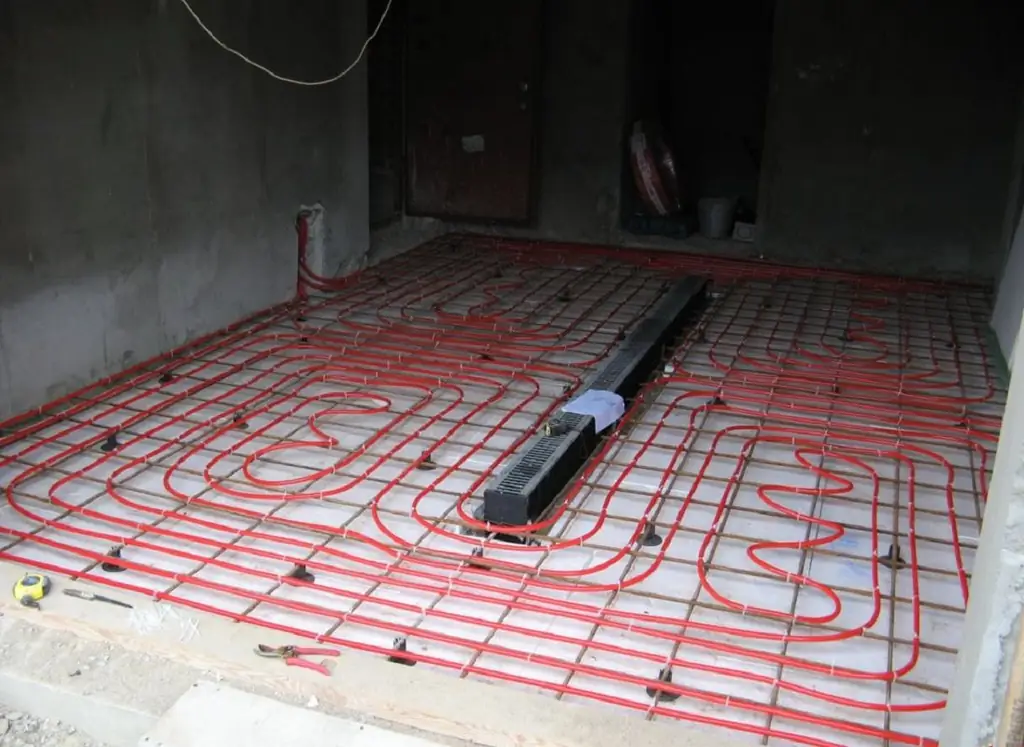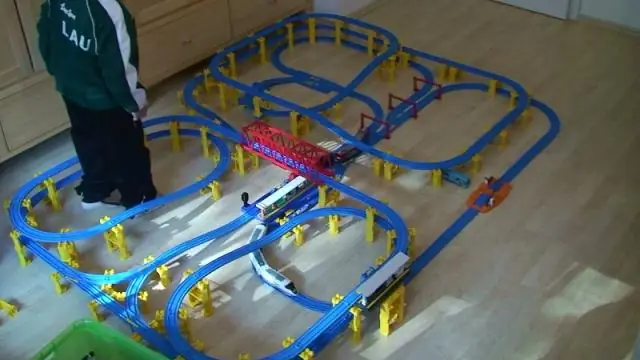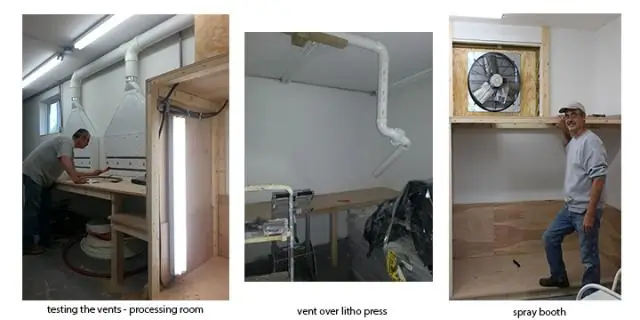
Table of contents:
- Author Bailey Albertson [email protected].
- Public 2023-12-17 12:53.
- Last modified 2025-06-01 07:32.
Heating the garage - what and how to do so as not to freeze in winter

Anyone who at least at the level of theory understands construction, plumbing and electrics, or knows how to tinker can independently make heating the garage. The article describes the advantages and disadvantages of different types of heating, this will help you choose the most suitable combination. By following the instructions, you can lay pipes or wiring with your own hands, connect equipment and start the heating system.
Content
- 1 Why the garage needs to be heated
-
2 Advantages and disadvantages of different types of heating
- 2.1 Creation costs
- 2.2 Choice by cost of energy carriers
- 2.3 Assessment of fire hazard and need for frequent maintenance
- 3 Power calculation
-
4 Where to start
4.1 Video: a way to heat a garage using liquefied gas
-
5 DIY installation
- 5.1 Wiring
- 5.2 Selection and installation of radiators and hot water boilers
- 5.3 Installation of pipes for hot water heating
- 5.4 Creating a chimney
- 5.5 Creating a warm floor
- 5.6 Start-up and first check of heating
Why the garage needs to be heated

Even the garage will not protect the car from frost without heating
Cold start in subzero temperatures poses a serious danger to the engine and other components and assemblies. The oil thickens and loses its lubricating properties, the hydraulic fluid hardly passes through the injectors, and the engine detonates. It is uncomfortable to repair or service a car at temperatures below 5 degrees, and besides, you can catch a cold. Therefore, caring car owners insulate the garage and install a heating system in it. This allows you to increase the temperature to comfortable values, as a result of which a cold start of the engine is easier, and it is much more convenient to service the car in warmth.
Advantages and disadvantages of different types of heating
To evaluate various types of heating, you must focus on the following parameters:
- heating costs;
- heating power;
- the need to monitor work;
- energy costs;
- Fire safety.
Air heating (infrared heaters, fan heaters and air heaters, both electric, wood-fired or gas-fired) will cost less than other options and do not require regular maintenance. Therefore, with a limited budget, they choose it. The disadvantages of such heating are as follows:
- infrared devices work well only in an empty garage, but if you put a car in it, then its lower part of the car will be much colder than the upper one;
- air heaters and fan heaters provide effective heating of only a small area, therefore, for uniform heating, it is necessary to install several devices in different places.
Water radiator heating will cost significantly more, but it is devoid of the disadvantages inherent in air heaters. Therefore, you only have to choose between different heat sources:
- Electric boilers are very cheap, but they require a constant connection to the mains.
- Gas boilers are expensive, require an electrical connection for the automation to function properly, and require a constant supply of gas. If the garage is not connected to the mains, then 5-10 cylinders have to be connected in parallel in order to ensure uninterrupted operation for 1-2 weeks.
- Wood-fired boilers are expensive and require frequent maintenance, but they are suitable for heating a garage of all sizes and do not depend on electricity. Installing a heat accumulator increases the period between boiler servicing to 2-4 days, but adds at least 200 thousand rubles to the cost of work.
Creation costs
Electric air heating will be cheaper than any other type. This is due to the fact that heaters, including infrared emitters, are sold in any hardware or hardware store, and they cost little. Inexpensive models of electric heaters (fan heaters and heat guns) will cost from 1 to 5 thousand rubles, depending on the power. Infrared floor and wall emitters, including convectors, you can buy for 3-8 thousand rubles. Ceiling heaters will cost 8-15 thousand rubles. In this case, you do not have to invest in installing water pipes, installing batteries or an expansion tank, but you will need to lay new wiring that can withstand the current consumed by the device.
A wood-burning stove-heater will cost a little more (5-15 thousand rubles). Its efficiency leaves much to be desired, and such a stove heats only while the fire is burning in it. Installation of full-fledged wood-burning heaters (Buleryan and analogues), the efficiency of which is noticeably higher, will not be cheap, because their cost starts from 30 thousand. In addition, they have the main disadvantages of a potbelly stove - demanding care and heating only during fuel combustion, therefore they are rarely used for permanent heating of the garage. The cost of gas infrared heaters and air heaters is 3-8 thousand rubles, but one large cylinder (50 liters) is enough for 30-50 hours of device operation. Therefore, you will have to use several cylinders united in a single network, otherwise you will change them every other day.
Water heating with a heating element (tubular electric heater), an electrode or induction boiler and traditional batteries will cost significantly more than gas and electric heaters due to the high cost of registers. The cost of such boilers is low and amounts to 3-8 thousand rubles, but to purchase a register, an expansion tank and pipes, you will have to spend at least 7 thousand rubles. The installation of a gas boiler will be even more expensive, because it is necessary to choose a model with a closed chamber, because only such devices effectively control the combustion of the fuel and the temperature of the coolant. Heating with a solid fuel water heater will cost even more because of the need to use a heat accumulator. The cost of such a boiler is not less than 15 thousand rubles, and the price of a heat accumulator with a capacity of 500 liters starts from 500 Euro. This device will increase the heating time from one firewood or coal to 2-3 days.
Choice by cost of energy

Often it is the cost of energy resources that is the main criterion for choosing the type of heating
The main criterion for choosing heating is the cost of electricity … In those regions where the cost of 1 kW * hour is less than 2 rubles, electric heaters are chosen. With the cost of one kW * hour in the range of 1-3 rubles, the cost of electricity and firewood will be comparable. At a cost of more than 3 rubles per kW * hour, the cost of heating with wood will be less, but you will have to spend money on a heat accumulator and heat the boiler once every 2-3 days, or add fuel 1-2 times a day. In the southern regions of Russia, where winter frosts last no more than 2 months, the use of electric heating is preferable, even at a price of 5 rubles per kW, because it does not require constant monitoring. Another disadvantage of wood heating is the need to install the boiler in a separate room. The exception is solid fuel heaters, but they are used only to raise the temperature during repair or maintenance of the machine. Therefore, wood heating is chosen only when it is impossible to use electric heaters.
Assessment of fire hazard and need for frequent maintenance
Solid fuel boilers and stoves not only require daily maintenance, but are also sources of increased fire hazard. Therefore, this method is used if the garage is located next to the house. Gas heating is less fire hazardous, but it is chosen if it is possible to use network gas or it is necessary, regardless of costs, to increase the heating service frequency to 2-3 weeks. In this case, several large gas cylinders are installed, which feed the water heating boiler through the reducer. This system must be checked every time the cylinders are changed.
Power calculation

By insulating the garage, you will reduce heating costs by 2-3 times
To determine the power of the heat source, it is necessary to calculate the amount of heat loss. This can be done both using calculations and taking average values. For example, the heat loss of a brick or cinder block garage, without heating and drafts, at a temperature of minus 20 degrees, is 0.1-0.2 kW per square meter (sq. M.). That is, for heating a garage with an area of 30 sq. m. you need 3-6 kW per hour. Insulation of the walls and ceiling of the garage can reduce heat loss to 0.04-0.08 kW per square meter of area. Therefore, for heating a well-insulated garage with an area of 30 sq. m. you need 1.2-1.4 kW of energy per hour. This will maintain a constant temperature of 15-17 degrees, which is sufficient for servicing or repairing the machine. By reducing the power of the heat source by 15-20%, you will lower the temperature in the garage by 5-10 degrees. This will allow starting a cold car without reducing the resource of the engine, even if a pre-heater is not connected to it. However, it will be uncomfortable to repair or service the car at this temperature.
Where to start
Before choosing a heating system, it is necessary to close up the cracks and insulate the garage. Without this, heating costs will be very high. To reduce heat loss, you can use both foam or polyurethane foam, and mineral wool. It is advisable to lay the insulation outside, this will save the walls from the appearance of mold. In addition, ventilation must be provided. The use of holes in the wall for this greatly increases the heat loss of the room, therefore it is necessary to install a recuperator. The average cost of inexpensive models of this device is 15 thousand rubles. Then you need to compare the costs of creating and operating various types of garage heating, and also determine whether you can independently perform the necessary work or have to invite a specialist.
For electric heating, it is necessary to lay new wiring that will withstand the current consumed by the heating element or heaters. The table below will help you determine the required wire size. Electric boilers are small in size, and their power is regulated using a special panel, so they can be installed anywhere in the garage. For a wood or gas boiler, with the exception of devices with a closed combustion chamber, it is necessary to create a separate room, a place for storing fuel and an insulated chimney. If it is not insulated, then a mixture of condensate and combustion products will quickly destroy a chimney made of any material. Also, you cannot use galvanized steel for the chimney, since when heated it begins to emit toxic substances. The chimney can be built from bricks (half-brick masonry) or a sandwich pipe can be ordered from the tinsmith. If you have the skills and equipment for tin work, you can make your own chimney using roofing iron and mineral wool.
Video: a way to heat a garage using liquefied gas
DIY installation
Heating installation consists of the following steps:
- laying of wiring (only for electric heating, if the old wires are not designed for the current consumed by the heater);
- installation of a boiler, air heater or heater;
- installation of radiators and an expansion tank (only water heating);
- pipe laying (only for hot water heating);
- chimney installation (only wood or gas heating);
- pouring underfloor heating (only for garages where the owner is ready to spend money on it);
- connection of gas cylinders (only for the corresponding boilers);
- filling the heating system with water (only for hot water heating);
- starting and testing heating.
Wiring

Stroba hides the wiring and protects it from damage
The laying of new wiring is necessary if the old one is not designed for the load power that the electric boiler will consume. If the old cable can easily withstand such a current, then use it. To install new wiring, you need a wall chaser and a hammer drill with a special crown for drilling holes for junction boxes. These tools can be bought or rented at most home improvement stores.
When choosing a cable, consider not only its cross-section, but also the material of the core. Aluminum wires cannot be connected directly to copper wires - this will lead to oxidation of the contact, an increase in its resistance and strong heating under load. Over time, this can lead to fire.

This table will help you choose the optimal cable cross-section corresponding to the power of the electric heater.
When laying out wiring, try to use straight lines and corners. Use junction boxes for cable outlet. They will indicate where the wire goes straight down. This will protect you from accidentally falling into hidden wiring during installation of shelves or other equipment.
To route the wiring, do the following:
- Mark the wall parallel to the ceiling, but 20 cm lower. You will lay the center cable in this strobe.
- Mark the locations for the junction boxes and the vertical conduits for routing the cables to the sockets and the boiler.
- Use a chaser to make grooves 10-20 mm deep, depending on the thickness of the cable.
- Use a hammer drill to drill holes for boxes and sockets.
- Route the cable, securing it with plastic fasteners and dowel nails.
-
Install junction boxes and sockets.

Switchboard The switchboard is designed for installing switches and connecting powerful electrical appliances
- Connect the center cable and taps in the junction boxes and plug into the outlets.
- Install the switchboard and connect the boiler to it.
Selection and installation of radiators and water heating boilers
When choosing radiators, it is necessary to consider not only their power, but also their service life. If you are not embarrassed by replacing batteries in 15-20 years, then install modern steel, aluminum or bimetallic products. If you need a service life of at least 30 years, use cast iron radiators (accordions). When choosing batteries, consider their capacity, as well as the reviews of people who installed them in their home. Some manufacturers indicate an overestimated heat transfer power, so such radiators will heat up weaker than necessary. If, for some reason, batteries from the store do not suit you, order their manufacture from a good welder. To install any radiators, you only need a hammer drill.

Bypass allows you to disconnect and remove the battery without stopping the circulation of water in the heating system
To install a radiator or electric boiler, do the following:
- Mark the places for the mountings that will bear the weight of the device.
- Drill the wall and install the mounts.
- Hang a boiler or battery on them.
- Fix the expansion tank not far from the boiler.
- Bring pipes to the device.
- Install taps that will allow you to replace the boiler or battery without draining the water from the system.
- Install a bypass parallel to each radiator - a thin tube that will circulate the coolant even when the radiator is removed.

Such a radiator, with equal power, will cost significantly less than one bought in a store
Laying of pipes for hot water heating
For any type of hot water heating use polypropylene pipes PN25. They can withstand temperatures up to 90 degrees and pressures up to 25 atmospheres, and their cost is low. All other types of pipes do not differ in performance, but they are much more expensive. The exception is XLPE pipes, but it is undesirable to use them due to the need to periodically check and, if necessary, tighten the fittings. Pipe diameters are determined based on the type of heating. For natural circulation systems, the diameter should be over 40 mm. If a pump is installed in the heating system (in the boiler or separately from it), then it is sufficient to use pipes with a diameter of 20-25 mm. It is also necessary to install an expansion tank, the volume of which should be 7% of the total volume of water in the system.
To work you need:
- soldering iron for polypropylene pipes;
- pipe scissors or hacksaw for metal;
- file;
- puncher.
Step-by-step procedure for laying heating pipes:
- Mark the piping locations. For heating with natural circulation, it is necessary to provide a slope of the supply pipe of 10 cm by 1 meter. For systems with forced ventilation, all pipes can be laid parallel to the floor at any height.
- Drill the holes for the retaining clips in 50-70 cm increments and install the clips.
- Cut the pipes into pieces of the required length using scissors or a hacksaw. If using a hacksaw, flatten the cut with a file.
- Warm up the soldering iron to operating temperature.
-
Insert the end of the pipe into it and slide the required fitting onto the special nozzle. Warm-up time 7-12 seconds.

Soldering polypropylene pipes Using a soldering iron, connect polypropylene pipes and fittings
- Connect the pipe and fitting and hold for 2-3 minutes. This is necessary to solidify the molten polypropylene. Do not confuse the direction of installation of pipes and fittings.
- After collecting the section of the supply or return pipe, insert it into the clips. Carry out further installation on site.

It looks like the correct installation of polypropylene pipes
Chimney creation
The easiest way to make a chimney is from sandwich pipes. They are sold in hardware and hardware stores. To create, first of all, think about whether you can lead it through the roof, or you will have to take it out the wall and then raise it above the roof level. For this job, you need a hammer drill with a chisel attachment, polyurethane foam and fasteners for a sandwich pipe.
When choosing the shape of the chimney and the place for its installation, keep in mind that the more turns this device has, the less the boiler draft will be. Therefore, it is advisable to install the smoke channel where it is possible to bring it out through the roof without bends and turns. If you are making a brick chimney, then keep in mind that the size of the channel should be at least half a brick.
To install a chimney, do the following:
- Determine its configuration based on pipe lengths and bends.
-
Mark a place for the chimney on the ceiling or wall.

Sandwich pipes Sandwich pipes are used to create an insulated chimney
- Use a hammer drill and chisel to punch a hole in the wall or ceiling and roof.
- When installing the chimney next to wood or flammable materials, install additional protection on it to prevent a fire.
- Assemble the chimney from the parts, insert it into the punched hole and put it on the stove or boiler.
- Put on the chimney protruding from the wall or roof with other elements that will provide it with the necessary height.
- Fix the pipe to the wall with special fasteners
-
Fill the hole with foam.

Chimney thermal protection Additional thermal protection of the chimney will prevent fire
Creating a warm floor
There are two types of underfloor heating - electric and water. The difference between them is that in some a heating cable is laid, and in others a thin (8-12 mm) polyethylene pipe. This type of heating can be done only in those garages where it is possible to raise the floor by 20-25 cm.
You will need:
- scissors for cutting reinforcement (you can use a grinder);
- building level 2-3 m long;
- pliers;
- construction vibrator;
- sharp knife.
Here is a step-by-step guide to creating a warm floor:
- Clean the garage floor from dust and cover it with 2-5 cm thick foam.
- Inside the garage from the reinforcement create a grid with a mesh size of 20x20 cm.
- Using small pieces and pieces of brick, raise the net 5-6 cm above floor level.
-
Lay the heating wire or pipe in loops over the mesh. Do not make the bending radius less than 5 diameters of the heating element.

Laying the heating element Laying the pipe or heating cable correctly will keep the garage warm
- Cover the perimeter of the room with foamed insulation, it will create the necessary thermal gap.
- Use a level to set concrete guides (beacons).
-
Pour concrete and compact with a vibrator.

Pouring concrete over lighthouses Thanks to the lighthouses, the surface of the concrete screed is very even
- Using a straight plank, level the concrete surface with the beacons.
- After 10 days, connect the warm floor to the heating system.
- After 28 days, you can start the heating and roll the car into the garage.
Start-up and first check of heating
- Electric infrared and convection heating is turned on and within half an hour they check the condition of all wires and the temperature in the garage. If you did everything correctly, the wires will not heat up, and electrical appliances will begin to emit heat.
- To start water heating, it is filled with water, air is removed using special valves and the boiler is turned on.
- For wood-fired boilers, the draft must be checked before starting.
- Electric boilers are checked in the same way as any other heating devices.
Thanks to heating, you can not only store but also service your car in the garage in winter. Thanks to the positive temperature, even in the most severe frosts, you will start the engine of your car without any problems.
Recommended:
How To Make A Bar Stool With Your Own Hands From Wood, Metal And Other Materials + Drawings, Photos And Videos

Bar stools manufacturing options. Required tools, materials used. Step-by-step description of the manufacturing process with a photo
How To Make And How To Paint A Concrete Fence With Your Own Hands - A Step-by-step Guide With Photos And Videos

Advantages and disadvantages of concrete barriers. Instructions and tips on how to make a concrete fence with your own hands
How To Make A Kite With Your Own Hands At Home: Options With Drawings And Sizes + Photos And Videos

DIY kite: the necessary materials, diagrams, drawings, manufacturing steps. How to make a kite of different shapes. Secrets of a Successful Launch
How To Make A Ping Pong Tennis Table (including For The Street) With Your Own Hands: Technology And More + Photos And Videos

How to create a variety of models of tennis tables for ping-pong with your own hands using a variety of materials and drawings
How To Make A Slime At Home With Your Own Hands - Without Sodium Tetraborate And Glue, From Hand Cream, Shaving Foam And Other Ingredients, Recipes With Photos And Videos

Is it possible to make a slime at home. Types of slimes and recipes for their manufacture, depending on the desired properties. Toy care features
